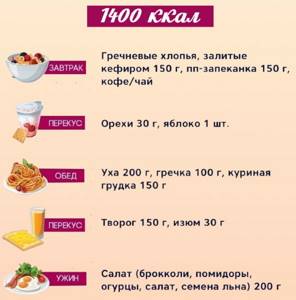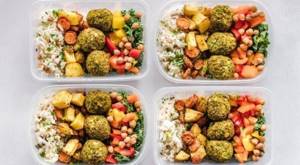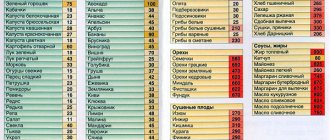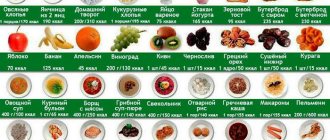Nutrition for weight loss plays a huge role. Nose The fitness industry intentionally encourages a complex approach that a weight-loss beginner simply doesn’t need. In fact, losing weight is very simple if you know the basic rules. Simple things work, and there is no point in trying something complex while simple things work.
The easiest steps on the planet for weight loss, in order of importance:
1. Find out your calorie intake and create a calorie deficit
2. Find out your protein intake
3. Find out the amount of fat
4. Find out the norm of carbohydrates
What is a calorie deficit?
A calorie deficit is a condition in which you consume fewer calories than you burn over time. Let's say if you burn 2,000 calories a day but only consume 1,500, you'll have a 500-calorie deficit. Another example: you take in 2,000 calories a day and burn 2,500.
Based on your diet and level of physical activity, you can achieve a calorie deficit in two ways - eat less or exercise more. Many people combine both methods.
From less to more
Some useful tips to get everything working.
- Start cutting calories gradually.
- First, reduce your energy intake by 10-15%, then add minimal physical activity - for example, regular walking.
- Then come to the gym, but don’t immediately jump into intense fat-burning workouts - start with a regular circuit for beginners.
- Just as appetite comes with eating, so your struggle for harmony should unfold gradually but confidently, along all flanks. You shouldn’t force things and try to surpass yourself - remember that everything is good in moderation.
Formula for gradually losing weight per week:
- 2-4 weight training sessions
- 2-2.5 hours of cardio training
- about 10 thousand steps every day
You should strive for this, but do everything gradually.
In addition, do not forget about activity in everyday life
A sedentary lifestyle is a real scourge of modern man. Internet, TV, a comfortable car, office work in a comfortable chair - as a result, we mostly sit and grow fat.
Fact: over the years of rapid development of information technology, the number of obese people has doubled.
Go to a dance class, ride a bike, roller skate, walk more, take a walk during a work break, do exercises while watching a TV show, walk the dog, refuse the elevator, do laundry by hand, etc. I assure you, you yourself will be surprised how much energy consumption will increase.

The Importance of a Calorie Deficit for Weight Loss
For weight loss, the most important factor is a calorie deficit. This factor does not depend on any conditions: neither on diets, nor on fashion trends in nutrition... If the goal is to lose excess weight, then the main condition here is a calorie deficit. Regardless of how you eat—whether cutting carbs, eliminating fat, or practicing intermittent fasting—you must be in a calorie deficit to experience weight loss.
A kilogram of body fat contains about 7,700 calories. Studies have shown that losing weight by 0.5-1 kilograms per week is safe.
Weight standards
Perhaps it’s worth starting with the most important thing, namely, determining weight standards, determining the level of body fat and the very concept of calorie deficit in dietetics.
There are classic formulas that determine weight standards for men and women:
- Height – 110 for men;
- Height – 120 for women.
For athletes, slightly different formulas for calculating weight are used, which take into account increasing mass. In particular these are:
- Height – 100 for men;
- Height – 110 for women.
How correct is it to follow this formula? Let's be honest - it is far from perfect and is only a statistical factor among athletes who are not involved in weightlifting.
What do you really need to consider? First of all, you need to take into account the following indicators, which will allow you to determine the weight that is optimal for you:
- Temperature factors;
- Bone thickness;
- Fat layer;
- Testosterone hormone levels;
- Level of general physical fitness.
As you can see in this formula there is not a single factor associated with growth.
Let's look at it in order.
How temperature factors affect total weight. The fact is that our body constantly adapts to its environment. And one of the important factors is thermoregulation, which is possible only with sufficient accumulation of energy reserves. This energy can be located in glycogen stores or fat. But the point is extremely simple. The hotter the region you live in, the lower your overall body fat level should be.
This means that the weight of equally trained athletes with the same metabolism and other related factors can differ by more than 10 kilograms. For example, for residents of the northern regions, the accumulation of excess fat is not genetic, but a purely opportunistic factor. Therefore, if they fall below a certain weight threshold, then this will become excessive stress for the body, in which it will try by any means to return to its optimum.
The next factor is bone thickness. Few people take this factor into account, which is a consequence of the original physique. But the weight of the bones is almost 30% of the total weight. And therefore, a person with heavy and wide bones can actually weigh 20 kilograms more than a professional bodybuilder with the same height.
Let's move on to another factor that determines weight standards - this is the fat layer. Regardless of other cumulative factors, for the average person it ranges from 15 to 25%. For athletes, this figure shifts downwards. Those. in fact, an athlete, despite his large mass, is thinner than a non-athlete.
The general level of physical fitness affects how much additional energy the body will store. And the level of hormones is the main regulator of overall body weight, as it can independently change the level of body fat, regardless of metabolic rate.
Only by taking into account all these factors can we determine the optimal weight for each person. Therefore, you should not pay attention to standardized formulas that reflect only a statistical sample among people in a certain region.
Having determined the optimal weight to strive for, you can move on to the most important thing - creating a calorie deficit.
How to calculate a calorie deficit in 3 steps?
1. Calculate your daily caloric expenditure for weight maintenance
Calculating your daily calorie expenditure will help you determine the amount you need to consume each day to maintain your weight. The number of calories may vary depending on age, gender, activity level and other factors, so this number will be different for everyone.
First, you need to calculate your basal metabolic rate or BMR . This is the amount of energy (calories) your body burns if you do nothing but rest for 24 hours.
To calculate your BMR, use the following formulas:
Men : BMR = 10 x weight (kg) + 6.25 x height (cm) – 5 x age (how old you are) + 5 Women: BMR = 10 x weight (kg) + 6.25 x height (cm) – 5 x age (how old you are) – 161
Now calculate the number of calories you burn each day doing physical activity (this is your total daily energy expenditure or TDEE ). To determine how many calories you need per day, multiply your BMR (the number you just determined) by your physical activity level, or PAL, which is shown in the table below.
Your BMR x activity level = calories needed to maintain weight
| PAL - Physical Activity Level | Physical activity rate | Description |
| Passive lifestyle | 1.55 |
|
| Moderate physical activity | 1.85 |
|
| High physical activity | 2.2 |
|
| Extremely active | 2.4 |
|
2. Adjust your calorie intake for weight loss
Once you know the number of calories you need for daily living, say 2500, you can calculate the number of calories you need to lose weight.
Considering that a kilogram of body fat is about 7700 calories, and we want to lose 0.5-1 kg of weight per week:
500 calorie deficit per day = 3,500 calorie deficit per week
700 calorie deficit per day = 4,900 calorie deficit per week
A calorie deficit occurs when you eat less and use more energy. If you're already on a fairly strict healthy diet and don't know how to cut calories, you may need to train a little harder.
If you are confident that you can reduce the number of portions and reduce the intake of carbohydrates or fats in your diet, you can focus on a calorie deficit that will be based on food. Tracking your calorie intake by weighing your portions is critical to these calculations.
3. Consider your physical activity
Diet changes are just one part of the plan to create a calorie deficit. Besides nutrition, you have to consider your workout routine. When you eat, the calories are placed in a plus column to represent your daily calories, and when you exercise, the calories are subtracted. To lose weight, you need to consume about 500 net calories per day less than your BMR.
Calories from food - calories burned from exercise = net calories
Calculating exactly how many calories you burn during exercise is difficult because there is no way to make accurate calculations. The best way to calculate the number of calories burned is to use a special device that is adjusted to a person's age, weight and activity level and measures heart rate.
There are equations that allow you to calculate this figure, however, it can be time-consuming and difficult. You can also refer to the table of calories burned during exercise.
Main menu
A calorie deficit for weight loss should not be a daily menu based on fasting and refusing any food in the name of diet.

1500 calorie menu for those who want to eat healthy:
| Products | Weight | Cal, kcal | Squirrels | Fats | Carbohydrates | ||
| Monday | |||||||
| Buckwheat porridge | 200 | 170.7 | 6.09 | 1.59 | 34.88 | ||
| Coffee | 150 | 136.4 | 2.97 | 2.63 | 4.94 | ||
| Strawberry jelly | 150 | 122.4 | 1.67 | 0.31 | 27.49 | ||
| Pike perch broth | 250 | 168.0 | 38.40 | 0.34 | 0.00 | ||
| Carrot-apple cutlets | 200 | 183.0 | 3.12 | 6.52 | 27.96 | ||
| Boiled pike perch | 200 | 145.5 | 31.95 | 1.95 | 0.00 | ||
| Apple | 165 | 77.5 | 0.66 | 0.66 | 16.17 | ||
| Frittata with zucchini | 150 | 103.1 | 4.94 | 5.52 | 7.94 | ||
| Curd and pumpkin dessert | 150 | 154.5 | 11.12 | 2.46 | 23.76 | ||
| Fruit smoothie | 150 | 141.6 | 5.28 | 2.88 | 19.92 | ||
| Yogurt bio-balance | 130 | 115.5 | 4.65 | 2.25 | 19.20 | ||
| Total | 1518.3 | 110.84 | 27.10 | 182.25 | |||
| Tuesday | |||||||
| Vitamin salad | 200 | 154,0 | 2,80 | 9,80 | 13,80 | ||
| Hibiscus tea | 250 | 12,5 | 0,75 | 0,00 | 1,50 | ||
| Curd cake with apples | 150 | 140,3 | 9,45 | 1,38 | 22,0 | ||
| Vegetable soup | 250 | 107,5 | 4,25 | 4,50 | 15,50 | ||
| Squid with beans | 200 | 296,9 | 18,64 | 20,90 | 8,74 | ||
| Spinach-pineapple detox smoothie | 238 | 104,7 | 2,38 | 0,48 | 22,37 | ||
| Cabbage casserole | 250 | 218,8 | 13,73 | 14,70 | 8,70 | ||
| Syrniki | 150 | 228,8 | 18,0 | 3,18 | 31,34 | ||
| Yellow tea | 150 | 211,5 | 30,0 | 7,65 | 6,0 | ||
| Total | 1474,2 | 100.0 | 62,59 | 129,95 | |||
| Wednesday | |||||||
| Omelette with green beans and milk | 200 | 182,4 | 11,20 | 12,60 | 5,40 | ||
| Coffee with milk | 150 | 136,4 | 2,97 | 2,63 | 4,94 | ||
| Tomato salad (with vegetable oil) | 200 | 140,8 | 2,28 | 9,76 | 11,22 | ||
| Cod stew | 200 | 202,0 | 19,40 | 10,20 | 7,80 | ||
| Fruits | 150 | 84,0 | 0,90 | 0,30 | 19,35 | ||
| Roasted pepper | 150 | 55,5 | 2,78 | 0,01 | 10,83 | ||
| Chicken liver pate | 100 | 150,0 | 13,0 | 5,40 | 3,20 | ||
| Carrot salad | 150 | 78.0 | 6,30 | 1,64 | 9,45 | ||
| Apple Golden | 200 | 106,0 | 1,0 | 0,40 | 21,40 | ||
| Berry smoothie | 360 | 136,8 | 4,68 | 4,32 | 19,80 | ||
| Curd cake with apples | 150 | 233,8 | 15,75 | 2,30 | 36,67 | ||
| Total | 1505,7 | 80,25 | 49,55 | 150,06 | |||
| Thursday | |||||||
| Whey bread | 100 | 260 | 7,80 | 10,45 | 4,37 | ||
| Coffee with milk | 150 | 136,4 | 2,97 | 2,63 | 4,94 | ||
| Eggplants in sour cream | 200 | 150,0 | 2,70 | 9,88 | 12,44 | ||
| Vinaigrette with vegetable oil | 150 | 90,6 | 2,86 | 2,21 | 14,85 | ||
| Jellied pike perch | 150 | 135,7 | 15,75 | 7,67 | 3,66 | ||
| Olivier with yogurt | 150 | 156,0 | 10,75 | 9,31 | 7,35 | ||
| carrot juice | 150 | 42,0 | 1,65 | 0,15 | 9,60 | ||
| Fried red rice (carrots, onions, champignons, sunflower oil) | 100 | 139,0 | 5,08 | 2,09 | 24,54 | ||
| Vitamin salad (vegetable) | 150 | 115,5 | 2,10 | 7,35 | 10,35 | ||
| Pear tea drink | 150 | 10,5 | 0,30 | 0,15 | 2,10 | ||
| Salted saffron milk caps | 75 | 16,9 | 1,51 | 0,60 | 0,75 | ||
| Pike perch broth | 300 | 252,0 | 57,0 | 0,51 | 0,00 | ||
| Total | 1504,5 | 111,08 | 52,99 | 94,94 | |||
| Friday | |||||||
| Scrambled eggs from 2 eggs with onions | 150 | 198,0 | 12,0 | 13,50 | 6,90 | ||
| Banana, Strawberry and Flaxseed Smoothie | 167 | 182,0 | 5,68 | 8,02 | 22,71 | ||
| Apple Golden | 165 | 87,4 | 0,82 | 0,33 | 22,71 | ||
| Vegetable salad | 100 | 76,8 | 9,62 | 2,45 | 1,81 | ||
| Greek fish soup in a slow cooker | 150 | 135,0 | 10,05 | 8,70 | 2,25 | ||
| Tuna pate | 100 | 66,6 | 9,17 | 2,39 | 1,98 | ||
| Cottage cheese and apple dessert | 142 | 103,7 | 10,51 | 1,42 | 11,93 | ||
| Chamomile tea | 100 | 1,0 | 0,00 | 0,00 | 0,20 | ||
| Orange jelly | 150 | 132,0 | 4,20 | 0,00 | 30,45 | ||
| Cupid baked in foil | 200 | 247,4 | 33,80 | 9,60 | 1,40 | ||
| Classic oat drink Nemoloko | 250 | 150 | 2,50 | 8.00 | 16,25 | ||
| Brie cheese | 45 | 131,0 | 9,45 | 10,35 | 0,00 | ||
| Total | 1510,9 | 107,80 | 64,76 | 113,54 | |||
| Saturday | |||||||
| Protein dish with chicken fillet and green beans | 250 | 152,5 | 20,50 | 1,93 | 11,78 | ||
| Coffee with milk | 150 | 136,4 | 2,97 | 2,63 | 4,94 | ||
| chicken broth | 300 | 45,0 | 6,0 | 1,50 | 0,90 | ||
| Oatmeal on water | 150 | 132,0 | 4,50 | 2,55 | 22,50 | ||
| Baked trout | 200 | 172,0 | 31,80 | 3,40 | 2,0 | ||
| Oat bread | 100 | 226,0 | 7,0 | 3,20 | 40,80 | ||
| Zucchini appetizer with cheese | 100 | 56,0 | 2,90 | 2,80 | 4,30 | ||
| Stuffed cabbage rolls with mushrooms | 370 | 462,5 | 15,91 | 2,22 | 55,46 | ||
| Curd dessert with raspberries and cookies | 150 | 284,0 | 9,75 | 7,80 | 47.10 | ||
| Total | 1513,9 | 101,33 | 28,03 | 155,30 | |||
| Sunday | |||||||
| Manno-oat pancakes | 100 | 230,0 | 7,0 | 7,50 | 23,90 | ||
| Green tea | 150 | 0,00 | 0,00 | 0,00 | 0,00 | ||
| Buckwheat with chicken in the oven | 280 | 448,0 | 25,48 | 27,16 | 26,88 | ||
| Soup with peas and meatballs | 285 | 136,8 | 7,98 | 6,84 | 11,12 | ||
| Zucchini salad with cucumber | 249 | 124,5 | 3,24 | 9,46 | 7,72 | ||
| Cabbage salad with cheese | 200 | 232 | 12,60 | 16,80 | 6,60 | ||
| Tarragon lemonade | 250 | 25,0 | 0,25 | 0,00 | 6,00 | ||
| Cheese Tofu | 100 | 73,0 | 8,19 | 4,20 | 0,60 | ||
| Carrot sponge cake | 70 | 226,8 | 3,01 | 13,30 | 24,22 | ||
| Total | 1496,1 | 67,76 | 85,26 | 117,03 | |||
In many of the dishes presented above, sour cream, cream and sunflower oil are added. To reduce calorie content, you can cook without these additives. But you shouldn’t completely exclude fats from your diet, as this leads to digestive problems.
How to create a calorie deficit?
Here are some tips to help you create a successful calorie deficit plan.
Focus on changes that are realistic for yourself
If you're already eating a healthy diet that includes lean protein, plenty of vegetables, and whole grains, cutting back on calories may not be the best option for you. You will probably have to exercise more.
On the other hand, if you're already working out at the gym two hours a day but haven't been paying too much attention to your diet, it may be time to cut out junk food and cut down on portions to start burning fat.
Don't reduce your calories too much
You know there are 7,700 calories in one kilogram, and you may be tempted to increase your calorie deficit to achieve weight loss faster. However, extremely low calorie intake or a significant deficit that results in rapid weight loss often results in unsustainable results. If you eat too few calories for a while, your body will begin to adapt to the new conditions. As a result, BMR slows down, which means the process of losing weight becomes more difficult.
Keep in mind that the most sustainable and long-term results come from losing weight by 0.5-1 kg per week.
Make changes to your workouts
If you're following a healthy diet but your workouts aren't getting you where you want to be, make sure you're challenging yourself. Your body may have already adapted to running for 30 minutes on the treadmill and is therefore running efficiently, burning fewer calories.
Try a HIIT workout instead of moderate cardio, or switch to a stepper or stationary bike.
Include cardio and strength training in your workouts
When exercising daily, cardio burns calories the most efficiently, but strength training is what makes the real changes in your body over time. Increasing mass through muscle building actually increases your BMR and, in the long run, results in more calories burned each day.
Strength training is doubly important during a calorie deficit because it will help you target fat loss while maintaining muscle mass.

You won't be able to compensate for the calories you get from unhealthy foods in the gym.
You might be thinking, “The bowl of ice cream I'm going to eat at night only contains 400 calories, which means I'll work out an extra hour at the gym and burn them off!” Don't rush to draw conclusions! Yes, calories can be burned and balanced, but our bodies need complex carbohydrates, healthy fats, and high-quality protein to stay healthy. You can get a few hundred calories in just a few minutes, but it will likely take you hours of hard work to burn them off in the gym.
For reliable long-term results, reduce the amount of food you eat, still make room for your favorite foods, and move more. This balance will lead to success.

Conclusion
Calculating a calorie deficit is based on scientific evidence, but it is not always an easy task. First, you must carefully examine your habits - both eating and exercising. You can then decide what changes to make to achieve long-term weight loss success. Remember that your goals should be realistic and the changes you make to your routine should be based on your specific situation. And don't forget that losing weight takes time, keep your goal in mind, be consistent and patient.
Articles on our website are presented for educational and informational purposes only. We do not recommend using article materials as medical advice. If you decide to take dietary supplements or make fundamental changes to your diet, first consult with a specialist.
Translation: Farida Seidova
Product table
Knowing how many calories you need to eat per day to lose weight also means knowing where those calories will come from. First of all, it is protein, which is the most important component of a diet for weight loss.
What does protein do:
- maintains muscle mass;
- saturates the body;
- helps burn calories.
To perform all functions, the body must receive from 0.8 to 1.5 g of protein for every 500 g of a person’s weight.
Which foods contain a lot of protein:
- chicken meat, without skin;
- all types of fish;
- lean beef;
- eggs;
- beans;
- milk;
- cheese.

When creating a menu, keep in mind that 1 g of protein contains 4 calories. Many foods contain minimal calories. They can be added to dishes to reduce calories.
Products containing up to 20 kcal:
- tomatoes;
- radish;
- pure water.
Products containing from 20 to 30 kcal:
- celery;
- bell pepper;
- broccoli;
- spinach;
- eggplant;
- pumpkin;
- Champignon;
- cowberry.
Many products contain from 30 to 50 kcal:
- green beans;
- zucchini;
- strawberry;
- watermelon;
- curdled milk;
- beet;
- cranberry;
- oranges;
- apples;
- apricots;
- kohlrabi.
When adhering to a deficiency diet, one should not forget about foods containing healthy fats: fish, cottage cheese, egg whites, olive, sunflower, hemp oil, and lean meats. In addition to animal fats, the menu should include foods with vegetable proteins: peas, beans, lentils, soy, nuts, seeds.
Don't forget about cheeses. They should be chosen with medium fat content, and remember that they strengthen the skeletal system, especially white cheeses. If a person is carried away by a sharp reduction in calories, the body responds with hunger and cravings for sweets. You can replace harmful sugars with dark chocolate, dried fruits, cottage cheese with berries, fruit mousses and jellies.










